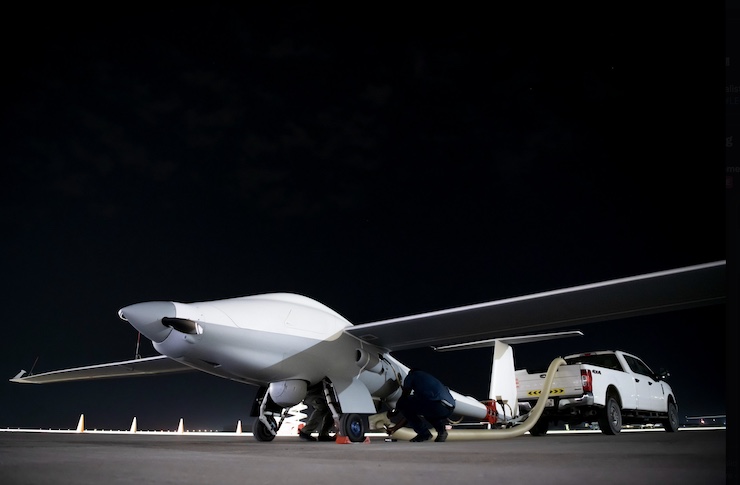
It comes as no surprise that the United States of America’s military forces have changed the way drones shape offensive and defensive protocols. After unparalleled success utilizing the Predator and Reaper drones from the 1990s onward, drones have become standard for all branches of the military in the United States. Today, it is estimated that the United States military uses 23 different types of aerial, terrestrial, and aquatic drones with a fleet supposedly comprising more than 11,000 individual drones. With how quickly drone technologies are advancing, these numbers will continue to grow.
In 2023, the Association for Unmanned Vehicle Systems International (AUVSI) reported that the US Department of Defense (DOD) had allocated $2.6 billion for the development of drone technology. Of the 29 new projects AUVSI said the DOD was funding, the majority would go towards aerial drones. One of these projects was a not-so-secret collaboration between the Air Force Research Laboratory (AFRL) and DZYNE Technologies.
On December 18, 2023, DZYNE announced that they had been awarded a $49 million contract to improve upon their existing long endurance drone technology. In a statement, DZYNE president Matt McCue said, “This contract represents a pivotal moment in the evolution of DZYNE’s long endurance programs. It allows us to expand our payload capabilities and augment our propulsion systems to deliver even greater utility and versatility to our partners at AFRL and beyond. DZYNE greatly appreciates the partnership with AFRL and various users, ultimately strengthening our national security posture.”
Headquartered in Fairfax, Virginia, DZYNE was founded in 2012 by Mark Page, one of the country’s most prolific aerodynamic engineers. As stated on DZYNE’s website, the company’s mission is “to create autonomous defense ecosystems to defend and protect against technology-enabled threats. Our AI-enabled air, land, and sea systems provide unparalleled integrated battlefield autonomy and build trust in robotic systems. Precision, agility, and a passion for protecting humanity are our guiding principles. We are not here to play – we are designing a safer future.”
DZYNE has worked on many projects with AFRL over the past decade. This latest project is to enhance their Unmanned Long-endurance Tactical Reconnaissance Aircraft (ULTRA). As explained by DZYNE, ULTRA is “an unmanned aerial system that provides customers a long endurance, GPS-hardened intelligence, surveillance, and reconnaissance platform with full global operational access at fractional cost and smaller operational footprint than other unmanned aircraft in its class.”
Designed to be an intelligence, surveillance, and reconnaissance (ISR) drone, ULTRA physically resembles a small manned glider. One of the aspects that makes this drone unique is that it is built with repurposed parts from manned gliders, allowing DZYNE to minimize production costs. One of the reasons DZYNE was awarded the contract with AFRL was to develop a lower-cost long endurance drone compared to the long-used Reaper drones that cost more than $30 million each.
Besides using repurposed parts, ULTRA is also built with off-the-shelf drone technology for cost reduction. “This is an example of a solution we brought to our customer for an urgent need where they just couldn’t afford the price that they were getting from General Atomics or Northrop Grumman for some of their more exquisite technologies,” said Mr. McCue. While the price of DZYNE’s ULTRA drone may be less, the quality of the product maintains the level of excellence DZYNE has become known for.
The drone can remain airborne for 80 hours at a time while supporting a 400 lb payload. The payload would primarily consist of what would be considered spyware technology. This includes an array of cameras, audio recording devices, and different scanners to provide the user with situational awareness. Further making the drone an ideal fit for US military branches is its ease of use. The entire system can be controlled by what DZYNE simply calls “point and click” operations. This means that with basic training, almost anyone can deploy and control the drone.
Mr. McCue said that long endurance drones, like the ULTRA, are the logical next step for military applications. More and more scenarios in far reaches of the world are requiring the US military to gather intelligence. A drone like ULTRA enables such missions while keeping individuals safe on the ground and far away from sources of conflict. As AFRL said in a statement, “The ULTRA system is truly unique in its ability to conquer the tyranny of distance that inhibits operational use of current unmanned platforms at excessive ranges required in areas of operations such as the Pacific.”
The unveiling of the ULTRA drone marks a significant advancement in the capabilities of unmanned aerial systems for the US Air Force. With its long endurance, cost-effectiveness, and sophisticated technology, the ULTRA drone exemplifies DZYNE’s commitment to innovation in defense. As global security challenges evolve, technologies like ULTRA are essential in maintaining strategic advantage and safeguarding military personnel in complex operational environments. As we look ahead, continued advancements in drone technology promise to further revolutionize military strategies and operations worldwide.
|